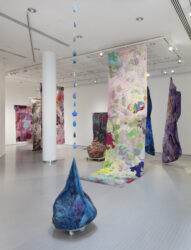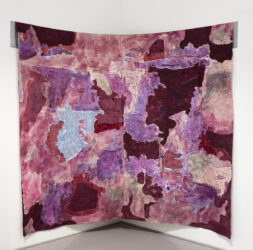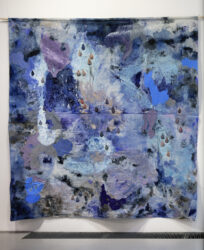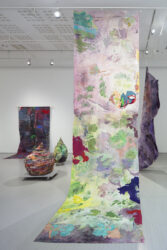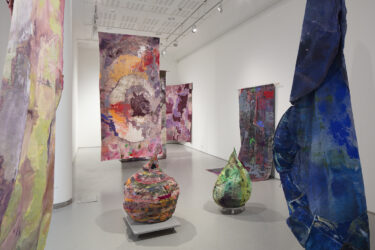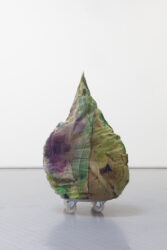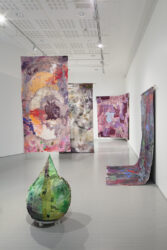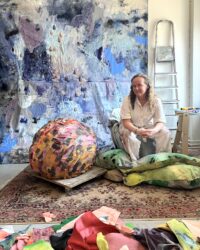Siiri Pohjolainen
TEARS (KYYNELEET)
13.6.2024 — 6.7.2024
Salty Rain
Siiri Pohjolainen’s large canvases drip paint and water, they shed tears. Tears, compactly shaped three-dimensional droplets, are blue like a reflection of the sky on a lake. Water is an indistinguishable part of Pohjolainen’s paintings – it dilutes the paint used in the canvases hanging from the ceiling and makes their surface matte and rugged. When drops fall on the plane of water-soluble paint, they seem to flow according to the shapes of the canvas. Moreover, tears lend their shape to some of the paintings that have been sewn to form drop-like sculptures. In the most recent of them, a string of small pearls flows from the ceiling and creates a large, all-absorbing tear on the floor.
Tears are a powerful subject in the history of art – signs of emotion joy, sadness, surprise and anger. At the time of the Renaissance, Giotto was among the first to paint tears flowing on the depicted face, as in the fresco The Massacre of the Innocents (1304–1305) in Scrovegni Chapel in Padua. The appearance of tears contributed to a change in the development of art, as instead of illustrations of rigid religious subjects, artworks began to reflect the world of humans by showing their emotions. Since then, tears have poured down the face of Sir John Everett Millais’ drowning Ophelia (1851–1852) and stained the pillowcase in Tracey Emin’s My Bed installation (1998).
Pohjolainen works with acrylic paint, oil pastels and collage on canvas. There, colours change according to the logic of shades. The scale of the paintings and treatment of colour remind us of the strong painterly character of neo-expressionist painting of the 1970s and 1980s, in which the difference between the figurative and the abstract was no longer significant. Pohjolainen not only adds layers of paint, but she also cuts, folds and superposes canvas to form collages. The scale of the works is abundant from the beginning, but it grows into new dimensions of depth wherever more pieces of canvas are sewn together. The cumulation of layers creates either two-dimensional paintings or three-dimensional sculptural installations.
Not only paint, but also the matte finish of oil pastels produce variation in the intensity of the surfaces. The opaqueness of pastels is related to the sensory quality of the scraps of suede applied to canvases. Their leathery surface will perhaps make the viewer wish to touch it and imagine an equal feel for pastel colors. Our fingers want to see, looking means touching.
In the gallery space, the visitor is attracted not only by the latent emotion hidden in the tears, but also by the dramatic installation of the works. It transforms the space into a stage or a colored theatre. In the middle of the background canvases, the viewer must relate with the works without reserve, not being able to contemplate the scene at a distance that would separate him or her from them. It is almost as if the double-sided canvases serve as a backdrop for the events taking place on the stage, where sculptures, crystallised teardrops, work as actors. The spectator’s task is to navigate between the scenes that arise from Pohjolainen’s works that offer multiple angles and aspects for viewing.
Martta Heikkilä, PhD
Thank you: Arts Promotion Centre Finland and Finnish Cultural Foundation, Uusimaa Regional fund



